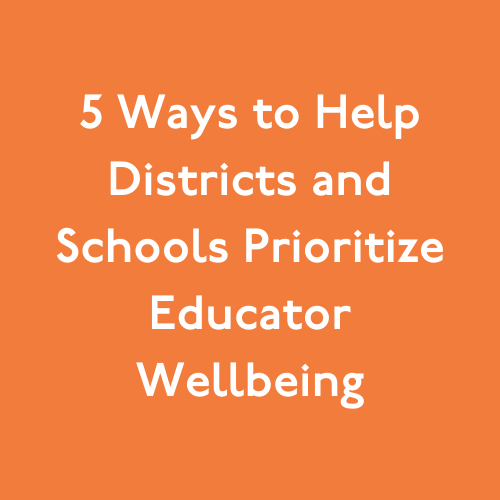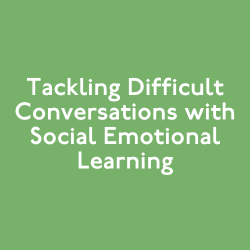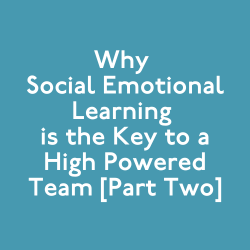This article was originally published in EdWeek Market Brief on Nov. 22, 2021.
By Move This World Founder & CEO Sara Potler LaHayne
—
The challenges facing educators this year are paramount: On top of the typical obstacles that show up in schools, this year educators are navigating safety plans, COVID responses, criticism from parents, and questions about how to support students as they readjust to a classroom environment while processing the impact of the past 18 months.
It’s no surprise that educators are leaving the field for job prospects that are more conducive for their health and well-being.
There has been a growing movement to improve teacher mental health since before the pandemic, but the pressures of COVID19 have made these efforts more critical than ever. School and district leaders need to make educator well-being a priority immediately — and regularly. Infusing well-being practices into the daily operating system of your school or district means making small shifts for a big impact on educators.
Here are 5 ways to help schools and districts prioritize educator well-being regularly:
1. Center and Close Meetings
Teachers don’t typically spend their entire day in meetings, but when they do sit down with colleagues it’s often the first (and only) time they are away from students. This is an opportunity for a collective deep breath. Instead of diving straight into your meeting agenda, give educators an opportunity to transition mentally. Starting with a brief centering exercise can help you avoid distractions like checking cell phones, reviewing lesson plans or grading papers.
Centering exercises should be quick and participatory, and can often include setting an intention for the meeting so that the team can make the most of their time together. Start with a breath together and invite teachers to think about a highlight from their weekend, or something they are looking forward to when they get home. Ask educators to focus on the feeling underneath these ideas, and share those feelings with the group. Or, start with a physical centering exercise like a Shake Off, prompting educators to shake each arm, leg, and their whole body as they count down from 5 to 1, ending with a deep breath.
Similar exercises can be used to close a meeting, providing a clear end to your time together and allowing educators to transition back to the busy school day. Some other great closing exercises include simply taking three deep breaths together, or expressing how you hope the rest of the day goes through a sound or a physical movement or frozen statue. Centering and closing meetings is a simple way to provide structure to your meeting time while also giving educators permission to tune into their feelings during the busy day.
See also: 10 Mindful Exercises to Start a Meeting
2. Create a Calm-Down Space for Educators
Not every school has an entire room to dedicate for educators, but creating a space that is designed for educator well-being not only demonstrates your commitment to prioritizing the well-being of your staff, but it also gives teachers permission — and opportunities — to take small moments in the day to care for themselves.
If you have an entire room, invest in comfortable seating, soft lighting, and essential oil diffusers to create a calm, quiet environment. Provide interactive elements like sensory toys, journal prompts, or meditation playlists that educators can use when they visit the space. Encourage teachers to use this space throughout the day as needed to reflect, unwind, or process stress of the day. If you are unable to provide a whole room, try to designate a corner of the main office or even a closet. If you don’t have any space to offer, try creating a virtual space or start a weekly newsletter with self-care ideas, wellness tips, and encouraging reminders.
3. Check the Emotional Temperature of Your Team
Educators are impressively talented at putting on a brave face and trudging forward, despite the stress or challenges in front of them. This is a critical skill when facing a classroom of students, but it also means that your daily walks down the hall seeing the smiling faces of educators is not the best gauge of their well-being.
Create intentional time to check in on your educators and take an emotional temperature check. For some schools, this looks like a daily visit for an individual conversation –how are you really, today? For other schools, this more often takes place in group meetings. The Circle of Trust is a fun exercise that allows you to take the emotional temperature of your team, and it’s a great centering exercise to start your meetings. Invite each person to say their name with a corresponding movement and how they are feeling that day with a corresponding movement. The rest of the group mirrors these responses back. This gives you insight into how your team is feeling and builds empathy for the emotional state of others.
4. Create Times for Play
Sometimes, prioritizing wellness means infusing laughter and play into the day. This is often more accessible for educators who may be resistant to other well-being strategies. Incorporate games like Zip Zap Zop or a simple counting game into team meetings. In Zip Zap Zop, the team stands in a circle. Invite one person to start with “Zip” as they clap and pass “Zip” to the person to their right. Try this around the whole circle. Then, introduce “Zap,” a clap that switches directions to the person to their left. Once your team has the hang of “Zip” and “Zap,” introduce “Zop,” a clap to any team member across the circle. When someone messes up — and they will — invite the group to clap, cheer, and celebrate before starting over.
Similarly, another simple game is to invite the group to count together. One person starts at 1, and the group popcorns as people continue counting. When two people say the next number, clap, cheer, and celebrate before starting over. You can set a goal to aim for, or simply see how high you can count and try to beat your record each time.
5. Celebrate Each Other
Feeling recognized and validated by your team is one of the best ways to support educator well-being. How else can you recognize the hard work of your team, or encourage them to celebrate each other? This could look like a shout out in a newsletter, a recognition during a staff meeting, or a dedicated bulletin board for staff recognition. Celebrate your team for more than their professional accomplishments, too. You can celebrate the educator who always makes the group laugh, or who tells great stories, or who is the “kid whisperer” that seems to solve all problems, or who bakes the best cookies. Your staff is critical in creating a positive, welcoming school culture, so find ways to recognize all of the unique attributes they bring that make your school special.
We’re in the middle of a long school year, and educators need the support of their school and district leaders to navigate the challenges and pressures they’re facing. Whether providing resources like health care and access to mental health professionals, or encouraging educators to use PTO, or infusing small moments of wellness practice into the operating plan of your schools, school and district leaders can have an enormous impact on the sustainability of an already-difficult profession.










